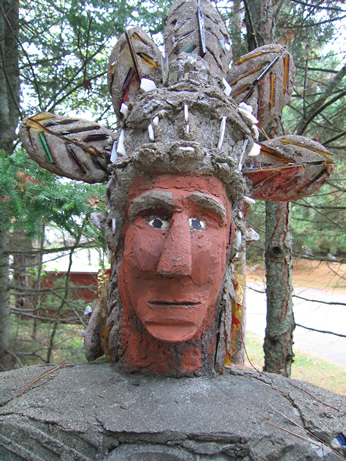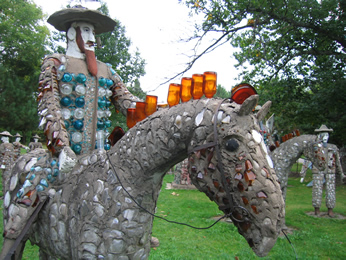It's hard to rank these on a national scale, but the work of Wisconsin artist Fred Smith "is beyond compare, and his is considered one of the most exceptional and original sculptural environments in the country," says Umberger. Smith, the creator of the Wisconsin Concrete Park in Philips had no schooling and could neither read nor write. Yet he built a 3.5 acre panorama of more than 200 imaginative sculptures that reflect the Northwoods history, legends and culture.
Born in 1886 of German immigrants who settled in the North Woods, Smith was influenced by the surrounding wilderness. A life-long logger, he felled vast stands of virgin timber by hand and became a local legend known for his great physical strength. Even when he got married in 1913 to Alta B. May, he kept on logging during winter. But in summer, he and Alta homesteaded a 120-acre farm near Phillips growing Christmas trees and ginseng, and cultivating an elaborate ornamental rock garden. They also raised six children.
In 1936 he built and operated the Rock Garden Tavern next to the homestead and in his early 60s in 1949 he gave up logging and sort of retired. During the next 15 years his productivity was simply amazing: He meticulously created and embellished a dazzling display of life size and larger than life size sculptures and tableaux of Indians, local people, mythical figures and animals.
Smith's art and materials were inspired by the world around him. In The Art of Fred Smith byu Lisa Stone and Jim Zanzi Smith is quoted as saying, "Them ideas is hard to explain, ya know. Might be something ya see, or like, or hear from someone else. Could be anything. It's gotta be in ya to do it."
The first element of his park was a barbecue of rock and low-relief concrete portraits to celebrate the Cleveland Indians victory over the Boston Braves in the 1948 World Series. He followed this with monumental low-relief plaques commemorating Indians, patriots and local characters. A deer tableau was inspired by an image he saw on a boy's sweater. Another is of Abraham and Mary Todd Lincoln inspired by a photo he saw of a monument honoring Lincoln and his wife created in Racine by sculptor Frederick Hibbard: Aptly so, Smith labeled his piece "The Second Monument of its Kind in the USA".
Smith's early works reflect an established tradition of commemorative monuments and memorials. As his work evolved he began to create more complex three-dimensional sculptures to immortalize mythical heroes, Indians, local legends and friends.
"Smith was able to do what he did because concrete was cheap and available and it was easy to work with and embellish without having formal education," says Jim Leary, professor of folklore at the University of Wisconsin-Madison and a co-founder of the Center for the Study of Upper Midwestern Cultures.
Smith created his concrete figures by digging molds in the ground, wrapping wooden support structures in wire and pouring layers of hand-mixed cement into the molds. He decorated the figures with paint and shards of broken glass, reflectors and other found objects (he liberally used Rhinelander Beer bottles from his tavern). Due to their massive size, he hauled the pieces to their sites with horses or a logging truck before setting them upright and anchoring them onto footings. He paid particular attention to their placement so that the statues fit into the natural landscape.
Real antlers and skulls grace deer, elk and moose. Horseshoes adorn the feet of each horse, and real plows and wagons are liberally used. In fact, Smith used nearly everything at hand and particularly appreciated the historical value of common objects.
"Throughout history, people have created art with local materials that reflect the world around them and their life experiences. Coupled with that is the immigrant or first generation experience of our concrete artists. They blended old world landscape and culture with a new landscape rich with resources and a mix of immigrants from throughout Europe," adds Leary. "It was a time of great cultural mixing, exploitation of the land, technological change and religious patriotism.
"We see this in the representation of American Indians and immigrants. We see popular cultural icons from such movies as Snow White and the Seven Dwarfs, which in its time was an incredible cultural phenomena. There are patriotic representations of American flags and eagles that celebrate the right to own land. There are representations of animals, such as deer, that in Europe were reserved as the 'Kings game,' but here could be hunted by the common man. From a cultural and folklore point of view, these works are extremely significant. The artists celebrate the fact that they are Americans within the larger concept of the changing culture around them," Leary says.
A statue of the mythical logging figure Paul Bunyan was Smith's favorite. But he believed that Sacagawea (there are more monuments to her in the U.S. than any other American woman) was the most important. Stone and Zanzi also note Smith said, "She was with Lewis and Clark all winter long. The woman didn't need no compass. She's the one that opened up the whole country. That's why I got so many Indians here. I like Indians because they're damn smart people."
Nature is expressed via sculptures of deer, elk, moose, bear and birds. Smith uncannily documented the facial features of Czechoslovakian, Finnish, German, Norwegian, Polish and Swedish immigrants. Lumberjacks cut down a tree with a real eight-foot saw, farmers work the land with horses and oxen, couples celebrate a Double Wedding, a photographer takes pictures, Mabel the Milker hand milks a cow, and there is the ubiquitous Wisconsin beer drinker.
Popular culture is illustrated via the Lion, Tiger and Angora Catsculpture that came from a photo of a painting from a book that he was given by Robert Amft, a Chicago architect and artist who frequented the area to fish. A sculpture of Ben Hur and chariot celebrates the movie of the same name. A gigantic Muskie Pulled By Horses celebrates the ubiquitous tall tales about the big one that got away.
Smith continued to sculpt until 1964, when just after having completed the last horse in his massive Budweiser Clydesdale tableau, he suffered a stroke that eventually laid him up in a nursing home until his death in 1976.
While well known locally, his national reputation was taking hold at that time. In 1974, the Walker Art Center (Minneapolis, Minnesota) mounted a landmark exhibition 'Naives and Visionaries,' exploring art environments of nine artist/builders, including Smith and Wisconsin's Herman Rusch who created Prairie Moon Garden. Yet, after Smith's death, the park's future remained uncertain and the ravages of nature were taking their toll.
Fortunately, in 1977 the Kohler Foundation purchased Wisconsin Concrete Park. Just as restoration was underway, a devastating summer downburst damaged three-quarters of the figures, and uprooted hundreds of mature pines. Oddly enough, the storm provided an opportunity for more thorough restoration. Some of the original rotted wooden armatures were replaced with steel and the pieces were reassembled to make them more impervious to extreme weather conditions. A few of Smith's statues were also taken to the John Michael Kohler Art Center for permanent display and as insurance, "to protect a selected few in the event of further weather damage or natural disaster," according to Terri Yoho, executive director of the Kohler Foundation.
When the restoration was completed the Foundation gifted the site to Price County for use as a park and outdoor museum. In 1995, a not-for-profit arts organization, Friends of Fred Smith, Inc. was formed to continue to preserve the park. This would suit Smith just fine. Stone and Zanzi further note Smith said his work was for "...all the American people everywhere. They need something like this." As such, he refused to sell a single sculpture or accept a commission, even though he was offered a pretty penny many times. "I never sell any 'cause it might spoil it for others."





